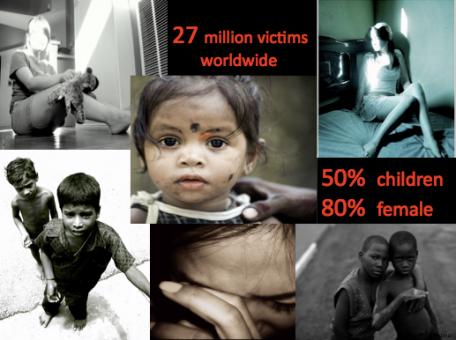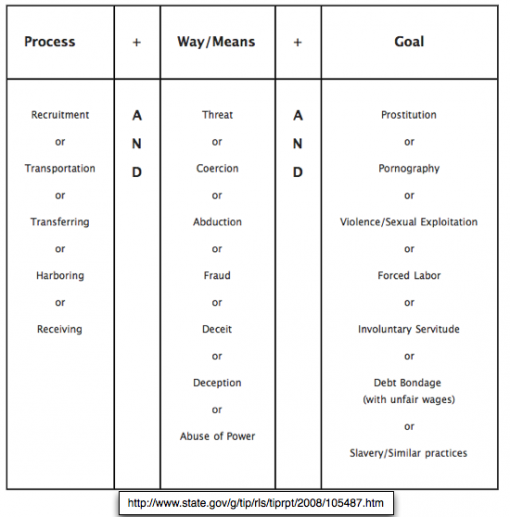Human Trafficking

"The victims of modern day slavery have many faces. They are men and women, adults and children. Yet, all are denied basic human dignity and freedom" --Obama
Human Trafficking is...

Slavery in the United States was thought to be ended in 1862 by Abraham Lincoln when the Emancipation Proclamation was issued to declare the freedom of slaves. Here we are, however, 148 years later and the world still witnesses slavery. Often, human trafficking is labeled as "slave-like" thus accepting the belief that slavery was completely eradicated years ago. This is not true, human trafficking is modern day slavery. Ambassador Miller for the State Department noteworthily says, "This is one of the great moral struggles of our day. We need to bring the same passion and commitment to this struggle that the abolitionists of this country brought to the struggle against slavery based upon color 160 years ago" (Batstone 4). Modern day slavery is a world-wide crisis that cannot be eradicated simply with a signature like Abraham Lincoln did with the Emancipation Proclamation, but must be combated with a united world force.
The United Nations defines human trafficking as, "the recruitment, transportation, transfer, harboring or receipt of persons, by means of threat or use of force or other forms of coercion, of abduction, of fraud, of deception, of the abuse of power or of a position of vulnerability or of the giving or receiving of payments or benefits to achieve the consent of a person having control over another person, for the purpose of exploitation" (United States...Health).
As the fastest growing criminal industry in the world and the second largest criminal industry in the world, second to the drug industry, Ambassador Miller is absolutely correct about the crucial action needed against human trafficking. Drugs and weapons can only be sold once, victims can be sold repeatedly. Every year traffickers generate billions of dollars in profits at the expense of victimizing millions of people around the world. The International Labor Organization estimates that profits accumulated through trafficking reaches around 32 billion dollars (Kara).
The U.S. Department of State's 2007 Trafficking in Person's Report estimates that there are 27 million victims worldwide (United States...Health). This information is of course hard to know exactly because of the nature of the industry. Within the victims, 50% are thought to be children and 80% women and girls (United States...Health). Out of the women and girls that are trafficked, 70% are trafficked into the commercial sex trade, while the remaining 30% are victims of forced labor (United States...Health). Sex trafficking is often put under the spot light, creating the false belief that it is the main type of exploitation and while it is for women, this is not true in large. Labor trafficking is more widespread simply because the worldwide market for labor is far greater than the demand for sex (Feingold).
Victims are exploited for purposes of commercial sex, including prostitution, stripping, pornography, and live sex shows or through labor exploitation such as domestic servitude, sweatshop factories, or migrant agricultural work. Human trafficking is not limited to these descriptions, but comes in many more different forms such as organ harvesting and the use of child soldiers. Traffickers use force, fraud and coercion to compel women, children and men to engage in these activities. Force involves the use of rape, beatings, and confinement to control victims. Forceful activity is especially used during the first stages of victimization called the "seasoning period". Breaking down the victim both physically and emotionally causes them to become more submissive and less likely to resist. Fraud involves false offers that induce people into trafficking situations. Coercion involves threats of serious harm or injury to the victim and the victim's family and friends. It is any scheme or plan that will make the victim believe that failure to obey will result in serious harm or physical restrain against any person.
The United Nations defines human trafficking as, "the recruitment, transportation, transfer, harboring or receipt of persons, by means of threat or use of force or other forms of coercion, of abduction, of fraud, of deception, of the abuse of power or of a position of vulnerability or of the giving or receiving of payments or benefits to achieve the consent of a person having control over another person, for the purpose of exploitation" (United States...Health).
As the fastest growing criminal industry in the world and the second largest criminal industry in the world, second to the drug industry, Ambassador Miller is absolutely correct about the crucial action needed against human trafficking. Drugs and weapons can only be sold once, victims can be sold repeatedly. Every year traffickers generate billions of dollars in profits at the expense of victimizing millions of people around the world. The International Labor Organization estimates that profits accumulated through trafficking reaches around 32 billion dollars (Kara).
The U.S. Department of State's 2007 Trafficking in Person's Report estimates that there are 27 million victims worldwide (United States...Health). This information is of course hard to know exactly because of the nature of the industry. Within the victims, 50% are thought to be children and 80% women and girls (United States...Health). Out of the women and girls that are trafficked, 70% are trafficked into the commercial sex trade, while the remaining 30% are victims of forced labor (United States...Health). Sex trafficking is often put under the spot light, creating the false belief that it is the main type of exploitation and while it is for women, this is not true in large. Labor trafficking is more widespread simply because the worldwide market for labor is far greater than the demand for sex (Feingold).
Victims are exploited for purposes of commercial sex, including prostitution, stripping, pornography, and live sex shows or through labor exploitation such as domestic servitude, sweatshop factories, or migrant agricultural work. Human trafficking is not limited to these descriptions, but comes in many more different forms such as organ harvesting and the use of child soldiers. Traffickers use force, fraud and coercion to compel women, children and men to engage in these activities. Force involves the use of rape, beatings, and confinement to control victims. Forceful activity is especially used during the first stages of victimization called the "seasoning period". Breaking down the victim both physically and emotionally causes them to become more submissive and less likely to resist. Fraud involves false offers that induce people into trafficking situations. Coercion involves threats of serious harm or injury to the victim and the victim's family and friends. It is any scheme or plan that will make the victim believe that failure to obey will result in serious harm or physical restrain against any person.
Work Cited
Batstone, David. Not For Sale. New York: HarperCollins Publishers, 2007. Print.
Feingold, David A. “Human Trafficking.” Foreign Policy 150 (Sept.-Oct. 2005): 26-30,32. JSTOR. Web. 16 Apr. 2010. <http://www.jstor.org>.
Human Trafficking Statistics. Washington D.C.: Polaris Project. PDF file.
Kara, Siddharth. Sex Trafficking: Inside the Business of Modern Slavery. New York: Columbia University Press, 2009. Print.
United States. Health and Human Services. Human Trafficking Fact Sheets. Washington: GPO, 2007. Print.
Feingold, David A. “Human Trafficking.” Foreign Policy 150 (Sept.-Oct. 2005): 26-30,32. JSTOR. Web. 16 Apr. 2010. <http://www.jstor.org>.
Kara, Siddharth. Sex Trafficking: Inside the Business of Modern Slavery. New York: Columbia University Press, 2009. Print.
United States. Health and Human Services. Human Trafficking Fact Sheets. Washington: GPO, 2007. Print.
Pictures Work Cited
“Human Trafficking is.” Chart. U.S. Department of State. Department of State, n.d. Web. 1 Mar. 2010. <http:/www.state.gov/g/tip/rls/tiprpt/2008/105487.htm>.
Sandman, B. Earthling. 3 June 2009. FlickrCC. N.p., 3 June 2009. Web. 4 Apr. 2010. <http://www.flickr.com/photos/15852546@N06/3591923254/in/photostream/>.
- - -. Man . 14 June 2009. FlickrCC. N.p., 15 June 2009. Web. 4 Apr. 2010. <http://www.flickr.com/photos/15852546@N06/3627801000/in/photostream/>.
Sandman, B. Earthling. 3 June 2009. FlickrCC. N.p., 3 June 2009. Web. 4 Apr. 2010. <http://www.flickr.com/photos/15852546@N06/3591923254/in/photostream/>.
- - -. Man . 14 June 2009. FlickrCC. N.p., 15 June 2009. Web. 4 Apr. 2010. <http://www.flickr.com/photos/15852546@N06/3627801000/in/photostream/>.
